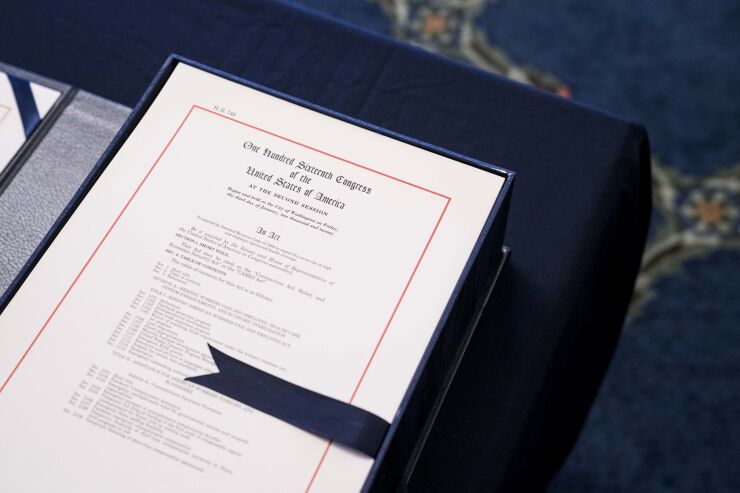Want unlimited access to top ideas and insights?
When looking across the planning landscape, it may seem the impact of recent legislation is clear. But as an advisor, you can never relax. New laws can send you scrambling to modify existing financial plans or implement different strategies altogether. Only by understanding this legislation — including what it means for your clients now and in the future — can you develop plans that meet clients’ financial goals, while also providing flexibility to adapt to the constantly changing topography. Here are a few of the most important legislative changes over the past few years, and what they mean for clients .
Bipartisan Budget Act of 2015: Closing the Social Security loopholes
Before 2015, a couple of long-standing Social Security strategies allowed married claimants to maximize their total lifetime Social Security benefits:

- File and suspend allowed retirees to file for Social Security prematurely and then immediately suspend those benefits to open them for their spouse.
- Restricted application strategy: Here, individuals filed for benefits but noted they were restricting those benefits to spousal benefits only. Why? A high-earning claimant could receive spousal beneAndrew Harrer/Bloombergs based on the spouse’s lower earnings record, while the claimant’s own benefit exponentially grew until age 70. At age 70, the claimant could switch to collect on his or her own record.
What’s changed? The
What does it mean for your clients? If a married client born before January 2, 1954, has not yet claimed benefits, assess whether the restricted application strategy should be used while it’s still available.
The TCJA's sweeping changes to tax code
It’s worth noting that many Tax Cuts and Jobs Act provisions (e.g., those affecting the tax rate and estate tax exemption) will sunset in 2025. Of course, proactively planning for sunsetting isn’t easy. Plus, no one knows whether the sunsetting will actually occur— or whether different laws may be enacted instead. Nonetheless, there are some planning options to help account for the potential reversion of the tax laws to pre-2018 rules.
Estate tax planning
What’s changed? The tax law change doubled the estate tax exemption to $10 million per individual (adjusted for inflation). Further, many states that previously had their state estate tax inextricably tied to the federal tax system followed suit and either eliminated the state estate tax or drastically increased the state estate tax threshold.
What does it mean for your clients? Individuals must evaluate whether their existing estate tax planning provisions have become obsolete or disadvantageous. As an example, in the decades before the TCJA, A/B trusts became ubiquitous with spousal estate tax planning. Because of the increase in the estate tax exemption, however, this type of trust planning could result in unnecessary restrictions on the surviving spouse. In addition, the estate beneficiaries could eventually incur more capital gains taxes due to a loss in a step-up in basis at the death of the surviving spouse.
Given this environment, a flexible approach that ensures that an individual’s estate plan is not rigidly tied to the laws in place at the time of its drafting may be in order. Would it make sense to give the surviving spouse the option to disclaim a portion of the estate to a credit shelter trust upon the death of the first spouse? This route provides the surviving spouse with the maximum control to determine whether there are estate tax concerns existing at the time of the first spouse’s death and, if so, to direct sufficient assets to pass to a trust that bypasses the survivor’s estate.
Charitable planning
What’s changed? The tax law change removed or significantly restricted many traditional itemized deductions. Consequently, the majority of taxpayers shifted to applying the standard deduction when completing their federal tax returns. But there was another unintended consequence: the chilling effect on charitable giving. Although the TCJA increased the AGI threshold for cash contributions to charity, charitable contributions remained an itemized deduction. So, if an individual or couple wanted to give to charity and see a tax benefit to their contribution, the gift plus all other available itemized deductions would have to exceed the standard deduction (now a much higher threshold to overcome).

What does it mean for your clients? An increasingly emerging course of action is to bunch charitable gifts. Bunching involves making an upfront gift of multiple years’ worth of intended charitable contributions, typically to a donor-advised fund, to ensure that a tax benefit is available in the form of sizable itemized deduction. After the upfront gift, donors of the DAF can then direct grants to their intended recipient that are in line with their charitable intent.
Gifting
What’s changed? As mentioned earlier, the increased gift and estate tax exclusion amounts should sunset in 2025 (i.e., the exemption amount will revert to 2017 levels). The
What does it mean for your clients? Many estate planning professionals are now looking to wealth transfer strategies that involve making large gifts (in excess of the annual gift tax exclusion) to family members or irrevocable trusts. For those with high-value estates, it may be worth exploring options for gifting assets from the estate while the exemption is still at unprecedented high levels.
Keep in mind that gifting can come at a significant cost to the estate beneficiaries in the form of a lurking substantial capital gain tax liability due to a loss in a step-up in basis. If the estate tax exemption never returns to a level that would make the donor’s estate taxable at death, then the donor would have created a potential tax liability by gifting without getting any appreciable benefit.
Roth conversions
What’s changed? The TCJA eliminated the recharacterization of Roth conversions as nontaxable, meaning do-overs are no longer allowed.
What does it mean for your clients? Although clients lost some flexibility with the loss of the do-over, there are still reasons they may want to consider a Roth conversion (e.g., low tax rates that may sunset and the loss of the stretch IRA).
SECURE Act: The death of the stretch IRA
The SECURE Act introduced substantial changes to the already complex retirement account rules.
What’s changed? The SECURE Act instituted the following provisions, to name just a few:
- Eliminated the age 70½ limit for contributing to an IRA
- Delayed the required beginning date from age 70½ to 72 for distributions from retirement plans and IRAs
- Permitted penalty-free withdrawals of up to $5,000 from qualified retirement savings plans to help pay for childbirth or adoption expenses (with repayment permitted)
- Expanded allowable expenses for 529 savings plans to include up to $10,000 in lifetime student loan repayments for the beneficiary and $10,000 for each of the beneficiary’s siblings
- Eliminated the stretch IRA, allowing only 10 years of deferral
Perhaps the most significant of these changes is the death of the stretch IRA. Previously, individual beneficiaries could stretch out the withdrawal of their inherited retirement account in accordance with their life expectancy. Now, most beneficiaries must withdraw their inherited retirement account within 10 years of the original owner’s death.
What does it mean for your clients? Unless a beneficiary meets an exception (e.g., spouse, disabled, minor child, beneficiary less than 10 years younger than decedent), a change in course may be required. Here, two popular strategies have emerged:
1) Roth conversions may allow retirees to pay taxes on tax-deferred accounts at their lower tax rates and leave a tax-free account to beneficiaries who are in their high-earning years and would incur significant tax liabilities in depleting an inherited tax-deferred account over a 10-year period. An inherited Roth IRA would need to be fully distributed within 10 years of the death of the account owner; however, it would enjoy tax-free growth and withdrawals for the beneficiary during that time period.
2) The surviving spouse of a decedent can disclaim (refuse) a portion of an inherited IRA, so that it can pass to the contingent beneficiaries. That way, beneficiaries could enjoy two 10-year withdrawal periods:
- One for the portion disclaimed commencing on the death of the first spouse
- A second for the balance of the account commencing after the death of the surviving spouse
CARES Act: Tax benefits for the charitably inclined
The CARES Act contains many temporary provisions intended to stimulate the economy and help those affected by the crisis (e.g., direct payments to individuals, access to forgivable business loans, increased eligibility for unemployment benefits). But there are also provisions applicable to any taxpayer that can be taken advantage of in 2020.

What’s changed? For the 2020 tax year, taxpayers can take an above-the-line charitable deduction of up to $300 for certain charitable contributions. Although this deduction isn’t available for those who itemize their deductions, the CARES Act did make changes to certain tax limitations for those who itemize to incentivize larger gifts in 2020. For 2020, the deduction available on cash contributions to charitable organizations has increased from 60 percent of a taxpayer’s AGI to 100 percent. Taxpayers can carry donations over 100 percent of their AGI to future years.
What does it mean for your clients? For those clients who are charitably inclined, maximizing tax benefits of charitable contributions in 2020 is key. Just one word of warning: contributions to DAFs are not eligible for these tax benefits in 2020. So, be sure your clients verify they are contributing to an eligible charitable cause before writing the check.





